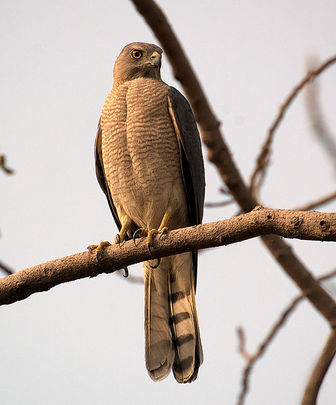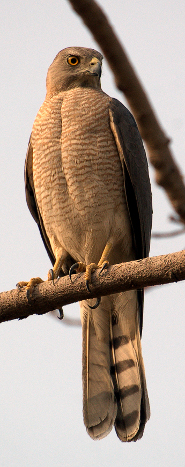Shikra
The Shikra is a widespread resident breeder throughout south Asia, especially India, and sub-Saharan Africa. It nests in trees, building a new nest each year. It lays 3–7 eggs.

Original source: Own work
Author: Ravi Vaidyanathan
Permission: GNU Free Documentation License
The Shikra - Little but Powerful Raptor
 The Shikra (Accipiter badius) also called the Little Banded Goshawk, the Indian Sparrowhawk, and Little Banded Sparrowhawk is a small, but powerful predator. It is a member of the Family Acciopitridae, which includes eagles, hawks, kites, and osprey. The Shikra has six subspecies ranging primarily from India to Africa. They vary in size from 26-32 cm (10-12 inches) with a wingspan of 55-61 cm (21.5 –24 inches) and weigh an average of 125gm (4.4 oz). The life expectancy is from 2.5–7 years. The female is larger than the male and has dark orange eyes, whereas the male has red eyes. They have a long barred tail that helps them with balance during hunting. The coloring is gray on the head and down the back and pale reddish-orange to white underbelly with darker bars. The coloring varies with the subspecies. The prey also varies over the subspecies. Shikra eat small animals like birds, lizards, reptiles, amphibians, insects, and squirrels. These little hawks attack from the limbs of trees or from flight as their vision is very acute. Their vision is eight times more acute than the vision of humans. Shikra have strong legs with sharp talons and a sharp, hooked beak, which they use to kill prey and tear it into pieces to eat. They are diurnal, hunting only during the day. They are found in woodlands, savannas, sub tropical, tropical areas and even in populated areas.
The Shikra (Accipiter badius) also called the Little Banded Goshawk, the Indian Sparrowhawk, and Little Banded Sparrowhawk is a small, but powerful predator. It is a member of the Family Acciopitridae, which includes eagles, hawks, kites, and osprey. The Shikra has six subspecies ranging primarily from India to Africa. They vary in size from 26-32 cm (10-12 inches) with a wingspan of 55-61 cm (21.5 –24 inches) and weigh an average of 125gm (4.4 oz). The life expectancy is from 2.5–7 years. The female is larger than the male and has dark orange eyes, whereas the male has red eyes. They have a long barred tail that helps them with balance during hunting. The coloring is gray on the head and down the back and pale reddish-orange to white underbelly with darker bars. The coloring varies with the subspecies. The prey also varies over the subspecies. Shikra eat small animals like birds, lizards, reptiles, amphibians, insects, and squirrels. These little hawks attack from the limbs of trees or from flight as their vision is very acute. Their vision is eight times more acute than the vision of humans. Shikra have strong legs with sharp talons and a sharp, hooked beak, which they use to kill prey and tear it into pieces to eat. They are diurnal, hunting only during the day. They are found in woodlands, savannas, sub tropical, tropical areas and even in populated areas.
Some of the subspecies migrate north to breed during the dry season. The clutch size is two to seven bluish-white eggs. The incubation is 28-30 days. The female incubates the eggs while the male provides her with food. The female takes sole charge of hunting, feeding, and raising of the young. The fledging period is about 30-35 days. The young birds remain in the parents habitat for the first year of their life.
The Shikra is a raptor and is an extraordinary hunter. It swoops down on the prey and kills even poisonous snakes with the hit from the sharp beak. It then takes the prey to a perch on a tree limb to eat. In turn, the Shikra is prey to larger raptors, snakes, large carnivorous mammals, as well as domestic cats and dogs. The Shikra is listed on the endangered species list as "Least Concern" or not endangered at this time. This small, powerful little goshawk is thought to number over a million in population over the two continents.
Picture of the skira by Ravi Vaidyanathan, licensed under GFDL
The Shikra is classified as Least Concern. Does not qualify for a more at risk category. Widespread and abundant taxa are included in this category.

Original source: Ravi Vaidyanathan
Author: Ravi Vaidyanathan
Permission: Some rights reserved
Family : Accipitridae
Genus : Accipiter
Species : badius
Authority : (Gmelin, 1788)
